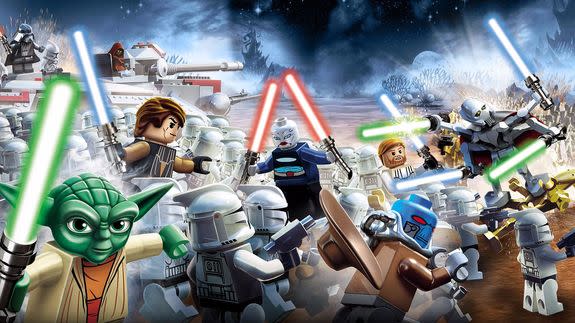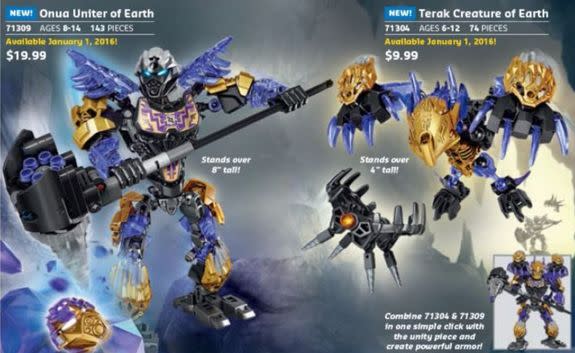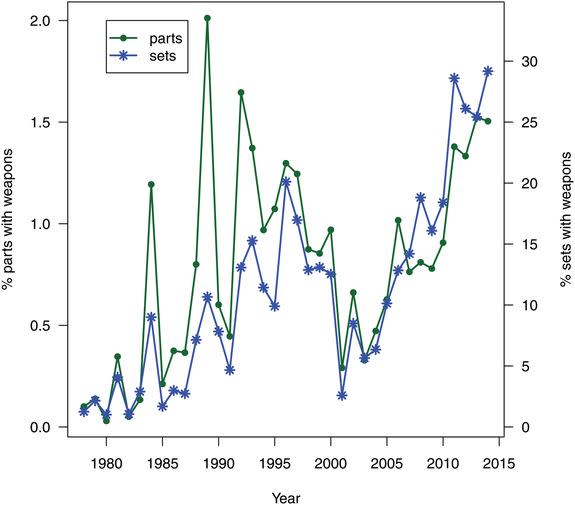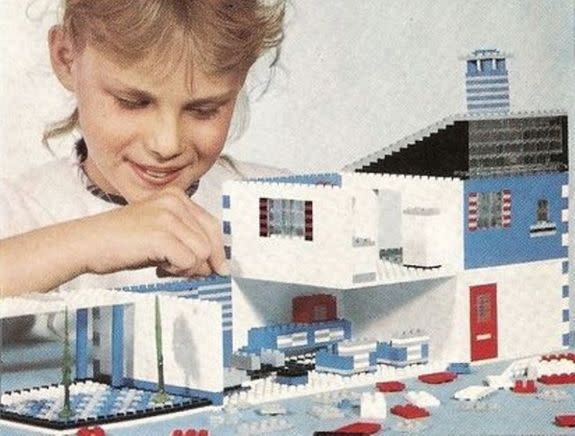Lego toys are getting more violent, study says

When my son was six-years-old, my wife and I refused to give him toy guns. If one arrived as a gift, it was swiftly spirited away – so quickly that he barely noticed its absence.
Instead, we bought him Legos... and he promptly built a gun.
I was reminded of this as I read over a fascinating new study from New Zealand’s HIT Lab at the University of Canterbury, which asks a simple question: Have Lego Products Become More Violent?
The short answer is, according to this study’s findings, "Yes."
Our results show that the violence of the depicted products has increased significantly over time. The Lego Company’s products are not as innocent as they used to be,” the study, published in the open-access journal PLOS ONE, states.
Even by the researchers’ own measure, it’s an unusual study. Instead of focusing on the potential deleterious effects of violent toys and imagery on children, they sought to analyze just how violent one of the world’s most popular toys has become since its inception in 1958.
“There is little research studying how violent the toys themselves have become; that is, how the toys’ design might connote, encourage or depict violence, aggression or anti-social behavior,” the study says.
The study’s lead author, Christoph Bartneck, is, incidentally, a former Lego employee and the author of eight books on Lego sets and figures. "My curiosity was triggered when I saw some very old Lego catalogs. Their products and the scenarios in which they were shown looked so peaceful," Batneck told Mashable via email, explaining why he launched the study.
Brick-by-brick
Bartneck and his team conducted two analyses. One looked at the proportion of traditional Lego bricks to weapons in sets, as well as the number of sets that contain weapons and how the number of weapon introductions compares to traditional brick introductions each year.
Secondly, they surveyed potential Lego customers to see how their perception of violence in the Lego systems has changed over time.

Image: lego
It was not always easy for the researchers to decide what in the Lego universe is a weapon and what is not. The Star Wars Death Star set, for example, is obviously a giant weapon. However, because it’s comprised of thousands of pieces of non-weaponry, it did not end up being classified as a weapon.
Researchers also relied heavily on the Lego fan site and online marketplace BrickLink, which has a complete catalog of every Lego piece ever released up to 2014 (the 2015 data was still being compiled at the time of the study).

Image: HIT Lab NZ, University of Canterbury, Christchurch, New Zealand
According to the study, the number of weaponized sets and parts has been steadily on the rise since the 1980s. There was a noticeable dip in the early 2000’s (right as the company was struggling financially), but by 2015, roughly 30% of all Lego sets featured some kind of weapon.
Though the study does not in any way try to tie together cause and effect between the use of toy weapons and increased aggression in children, it's obviously a question many Lego-buying parents may be asking.
As far as Bartneck is concerned, the scientific evidence is still inconclusive. "Playing out conflicts is essential for children. Our study was not designed to investigate the relationship between the violence in toys and the behavior of children," he said. Bartneck actually buys Lego bricks in bulk to create unusual, large-scale creations. |
Construction only
From 1958 until the late 1970s, Lego parts were primarily mini construction proxies, and the early advertisements for the Lego system typically showed children and families building houses, boats and skyscrapers. According to the researchers, the first weapons, a sword, a halberd and a lance – fairly tame weaponry – did not appear until 1978.
The turning point for Lego, though, was the introduction of themes and pop culture tie-ins. A 1995 Pirates theme (canons, hand guns), resulted in a weapons spike, according to the study.
The researchers noted that the Star Wars theme, which launched in 1999, did not shift the overall balance of violent weapons and sets, but they also believe that the simultaneous discontinuation of some other weaponized sets may have offset its introduction.

Image: lego/1000steine
To measure how people perceive the sets, the study team culled 20 or so set images from Lego’s own catalogs produced over the last 40 years and showed them to 161 people who then answered a series of questions.
The respondents were asked to rate the perceived violence (shooting, threatening, hitting, fighting, etc.) in each image. In general, they reported a dramatic increase of violent imagery since the 1980s. However, the research also found that the majority of violence was seen as playful (63% in 1980). That perception hasn’t actually changed much in the last 40 years (there was a shift, but it could not be measured as statistically different from no change at all).
Researchers also noticed that more of the violent themes were set further in the future, while the clarity and realism of the Lego violence also rose.
“Currently, around 40% of all pages were coded by participants as indicating some type of violence. In particular, scenarios involving shooting and threatening behavior have increased over the years,” the study found.
Lego's perspective
Legos, obviously, are not created in a vacuum. They’re often based on TV shows and movies aimed at children. Even the researchers note that Lego is not alone in this. Other studies have shown that the relatively tame Playmobile sets have also added more violent parts and themes.
When asked about the study and its findings, a Lego spokesperson sent this statement to Mashable:
Back at my house, we gave up the violent toy battle more than a decade ago. My son is now 21 and his Lego gun, along with most of his collection of toy arms and ammo, sit unused in the basement.
He still keeps his light saber close at hand, though.
